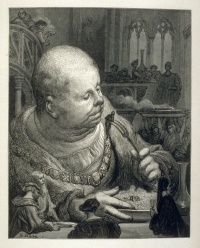Book illustration
From The Art and Popular Culture Encyclopedia
(Difference between revisions)
| Revision as of 10:54, 11 July 2010 Jahsonic (Talk | contribs) ← Previous diff |
Revision as of 20:51, 8 January 2014 Jahsonic (Talk | contribs) Next diff → |
||
| Line 1: | Line 1: | ||
| + | [[Image:Illustration by Gustave Doré, 1873.jpg|thumb|left|200px|'''Gargantua eating six pilgrims''' from ''[[Gargantua and Pantagruel]]'' by [[François Rabelais]], as illustrated by [[Gustave Doré]]]] | ||
| + | [[Image:Pantagruel by Gustave Doré (prologue).jpg|thumb|right|200px|[[Pantagruel by Gustave Doré (prologue)]]]] | ||
| + | [[Image:Friar John and Panurge.jpg|thumb|right|200px|[[Friar John]] and [[Panurge]] give the ''[[Blason and contreblason du couillon]]'' by [[François Rabelais|Rabelais]]]] | ||
| {{Template}} | {{Template}} | ||
| + | The '''book illustration''' is specific type of [[illustration]], which appears in books. Some of modern illustrations are performed by American Society of Children's Book Writers and Illustrators. | ||
| + | Modern book illustration comes from the 15th-century [[block book]]s. and closely followed the development of [[printing]]. The [[xylography]] and [[lithography]] triggered the production of illustrated issues and were exploited by such masters as [[Daumier]], [[Doré]] or [[Gavarni]]. | ||
| + | ==See also== | ||
| + | *[[Bookbreaking]] | ||
| + | *[[Illustrated art history book]] | ||
| + | *[[Illustrated bible]] | ||
| + | *[[Illustrated fiction]] | ||
| + | *[[Picture books]] | ||
| {{GFDL}} | {{GFDL}} | ||
Revision as of 20:51, 8 January 2014

Gargantua eating six pilgrims from Gargantua and Pantagruel by François Rabelais, as illustrated by Gustave Doré
|
Related e |
|
Featured: |
The book illustration is specific type of illustration, which appears in books. Some of modern illustrations are performed by American Society of Children's Book Writers and Illustrators.
Modern book illustration comes from the 15th-century block books. and closely followed the development of printing. The xylography and lithography triggered the production of illustrated issues and were exploited by such masters as Daumier, Doré or Gavarni.
See also
Unless indicated otherwise, the text in this article is either based on Wikipedia article "Book illustration" or another language Wikipedia page thereof used under the terms of the GNU Free Documentation License; or on research by Jahsonic and friends. See Art and Popular Culture's copyright notice.
.jpg)


